The Gezi-Movement and the Politics of Being-There: Offline and Online Participation
 Sunday, September 13, 2015 at 3:27PM
Sunday, September 13, 2015 at 3:27PM Sinem Aydinli
[ PDF Version ]
In an instance of graffiti art connected to the Gezi Movement,[1] the protester-cum-artist proclaims, “Tayyip, Winter is coming.” This is a joking reference to Recep “Tayyip” Erdoğan, the 25th and current Turkish Prime Minister and chairman of the ruling “Justice and Development Party” (AKP), in office since 2003. The slogan also implies being ready for the “winter,” as a warning of the happenings to come, referencing the Game of Thrones TV serial while also referring to the demographics of the young protesters steeped in the global popular culture.[2] This graffiti signage was significant like other inscriptions as it gives one insight into the habits of the protesters, including their own array of popular references from television, poetry, and music.[3] Most importantly, the graffiti leads us to see how the young protesters appropriate and communicate their own quality of political resistance within the terms of global popular cultural forms.[4]
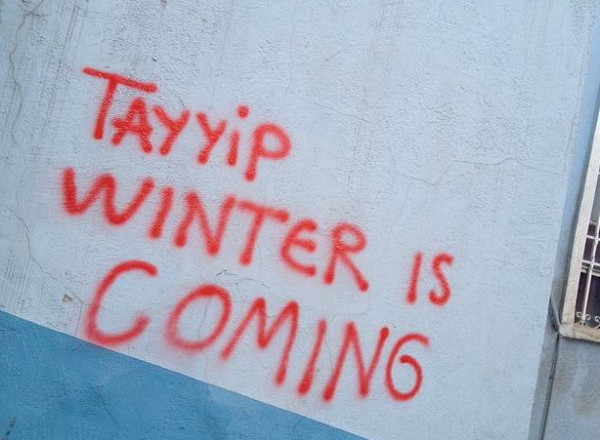
Figure 1 Tavyip Winter is Coming
Their strategy of presence resonates between the physical public space and the circuits of social media, both online and offline. The protesters’ creativity was evident in each and every micro practice: formative sloganeering and a language of protest that appeared in the Gezi Park activities and social media practices.[5] Also, they created hashtags and published instantaneous news feeds to inform the other activists about tear gas, the location of water-canons, police attacks and so on.[6] In addition to each protesters’ singularity, their plurality as manifested in the physical space of Gezi, as a public (square) movement, announced the advent of counter practices (as appearances) such as the affective and affirmative use of (political) language—represented through graffiti—and it also warned people about the deficiencies and hypocrisy of the media. The Gezi Movement naturally embodied daily life through the variety of participatory practice.[7]
In this paper, I focus on two aspects of the politics of “being-there,”[8] in order to affirm an internal relationship between both physical space (of appearance) and what I assert to be a secondary quality of presence, as being online. Put differently, I equally refer to the physical appearance of the protesters in the space, namely in the Gezi Park, in relation to their political language of graffiti, and their online participation practices which enabled them to communicate with each other after police/tear gas attacks. Most importantly these practices included publishing the news about what was not shown by the media outlets during and after the demonstrations. Both the graffiti and the e-participation imply that the offline and online spaces of the appearances establish the reality of one’s self, one’s own identity and the reality of the surrounding world.[9]
I use the concept of “being-there” in order to discuss the possibility of new political participation practices in terms of the engagement of protesters “with” and dwelling “in” both an offline and online “space of appearance.” In addition to this, the concept of “being-there” alludes to Hannah Arendt’s idea of “the space of appearance,” which refers to “the space where I appear to others as others appear to me, where men exist not merely like other living or inanimate things but make their appearance explicitly.”[10] Thereby, I discuss “the space of appearance” in relation to the graffiti by implying that the protesters' physical being in the streets turned into their voice, namely, their “words,” which made their appearance explicit. Further, the significance of online participation practices since Gezi created its own media as “extended Gezi” which enabled the protesters to eliminate their mainstream media-based thoughts about the ones who belong to different identities or groups.
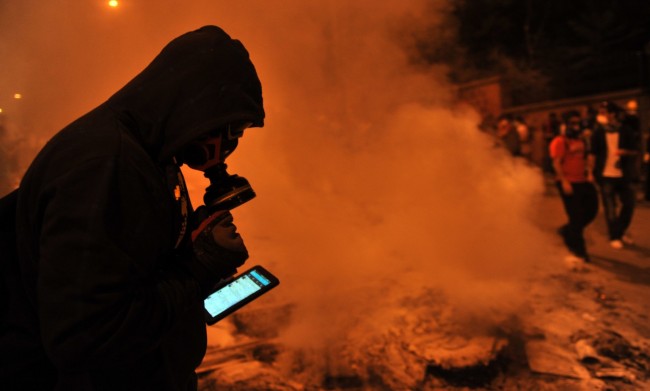
Figure 2 A Protester tweeting on her mobile phone[11]
When the squatting in Gezi Park began,[12] thousands of people came together without any clear target—united only in their awareness of the domination and authority of the government.[13] In the eyes of the Prime Minister, people were there to save trees and the park from being demolished. While describing the event, the Prime Minister claimed that “It is a mere matter of three to five trees” which also turned into another reference among the protestors in the following and vehement days of the resistance. So they wrote: “It was not a mere matter of three to five trees, don’t you still understand?” which implies that the occupation was the outcome of a cumulative process. When on May 28, 2013 bulldozers came to uproot the trees, activists were already there keeping guard of the park, since the bulldozers had broken down the walls the previous day. May 28th was the first day of tear-gas attack, and the symbol of the Gezi Park “woman in red” was shot on this day.[14]
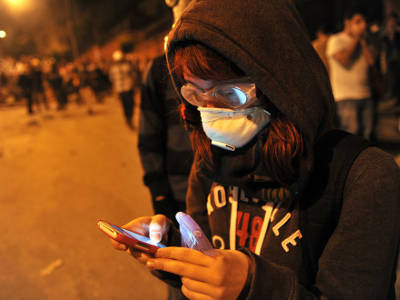
Figure 3 A protester texting via her mobile. The Atlantic[15]
Yet, Gezi, as “the Gezi event”, had different sufficient reasons[16], which were prior to it but it is mostly about the authoritarian governance. Also, pro-government media outlets manipulated the facts, surveillance strategies increased in intensity, and Internet restrictions expanded. The Prime Minister’s responses were becoming increasingly aggressive and authoritarian to any demonstrations or any critiques by journalists, opposing groups, students and even twitter users. In addition to blaming those people who were against him, by using words such as marginals and drunks (ayyaş), on a TV appearance during the time when demonstrations were going on, Erdoğan proclaimed that “There is a problem called Twitter right now and you can find every kind of lie there… The thing that is called social media is the biggest trouble for society right now.”[17]Also, the word, capulcu[18] (the looter) was the word that the prime minister used to describe the protesters. The word was re-appropriated by the protestors, and it referred to the people who actively participate in the movement, specifically those who contributed the resistance within their own words and deeds. So capulcu actually serves as an umbrella identity for the protesters.[19]It was because the cumulative authoritarian government actions that people revolted against the regime in pursuit of egalitarian ideals by occupying Gezi Park and Taksim Square, sites which already belong to the public.
The Gezi was a leaderless resistance movement but there was an umbrella organization, Taksim Dayanışması [Taksim Solidarity],[20] which gave some direction to the movement (see figure 4). Even though the Taksim Solidarity did not act as a leader, the diverse groups that made up the movement followed the demands in the hope of providing an autonomous space and an egalitarian future. Gezi was not a “matter of three-five trees”; rather it was an uprising to reclaim the universal human right to freedom and democracy.
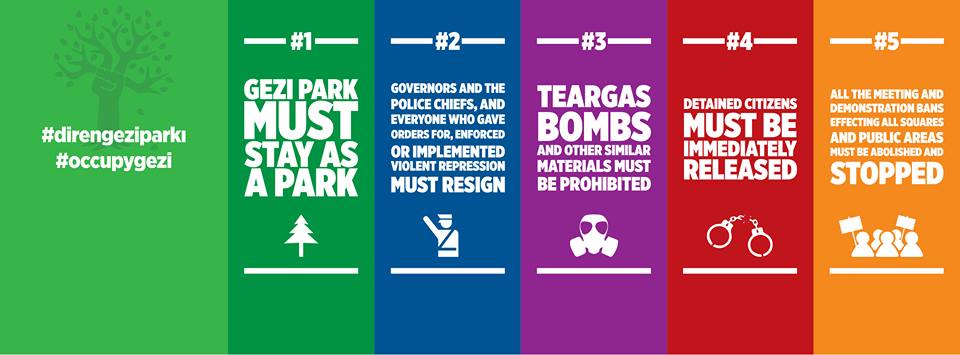
Figure 4 The main demands of the protesters through the movement and the after. The hashtags were used on all written materials. #direngeziparkı (#resistgezipark)
The first element of the politics of “being-there” refers to the “space of appearance” in relation with the slogans and graffiti through the Gezi Movement. It was the space where the physical proximity of the protesters generated speech (“words”) and action (“deeds”) by being-together. As Arendt writes, “The space of appearance comes into being wherever men are together in the manner of speech and action, and therefore predates and precedes all formal constitution of the public realm and the various forms of government, that is, the various forms in which the public realm can be organized.”[21] So as Arendt claims, the peculiarity of this space goes along with not only the people who are there but also the appearance of their activities.[22] Via the Gezi Movement, these political appearances, in the space, manifested themselves through some creative and joyful activist practices that involve language such as slogans, references, and hashtags. Also, the protesters were communicating with the PM through the graffiti. For instance, while Erdoğan had officially visited Africa during the demonstrations, the protesters humorously wrote what they demanded from him: Please don’t come back.[23] They communicated with the PM through their “words” as appeared in the space. Also, most of the protesters in the street did not have political stance before, nor they did not define themselves through any political ideology.[24] They are making sense of the world through the heterogeneity of their acquired political existence through the space.[25]
Also, they were answering the question of “who are you” which was implicit in both their words and their deeds[26]: The protesters were mostly young, students; leftists, Kurds, Kemalists (the strict secular and nationalist people, following “the founder” Ataturk); anti-capitalist Muslims, Alawites (a complex Anatolian religious and cultural group who follows Imam Ali, different from Sunni-Muslims); LGBTQ; and football fans. Put differently, these identities were just their appearances as such to each other through the banners read and the slogans heard. Usually, one could not imagine them together, but they were there—by being together, so they inherently proposed a new politics of “being there.”
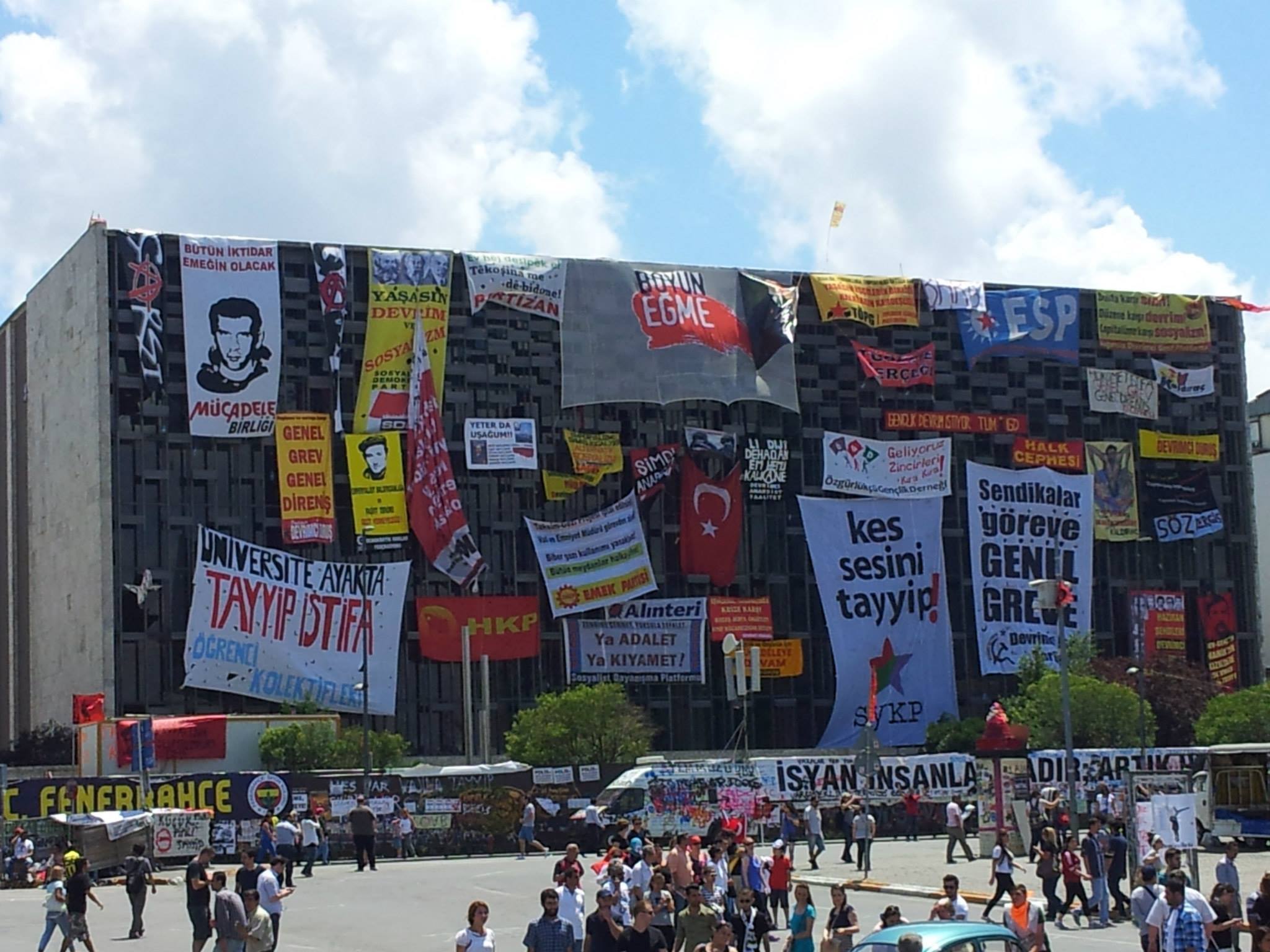
Figure 5 via Istanbulda Neoluyor
Certainly, the heterogeneity was read through their “appearances” (through the banners and graffiti) which the space enabled us to recognize. Thereby, the streets serve as a site for knowing the other without media. It is there that they learned about each other and their own collective construct of truth.[27] Still, these diverse groups did not have a direct aim and they had different reasons for being there, but mostly it was due to the prime minister’s authoritarian style of governance.[28] During the movement, even all the posters, banners and flags of different opposing groups, as “appearances” (see figure 5) were seen on the AKM (Ataturk Cultural Center) building located in Taksim, which will also be demolished due to the urban “redevelopment” plans. Most of the slogans and the graffiti implied that they also opposed the traditional language of the oppressed groups.

Figure 6
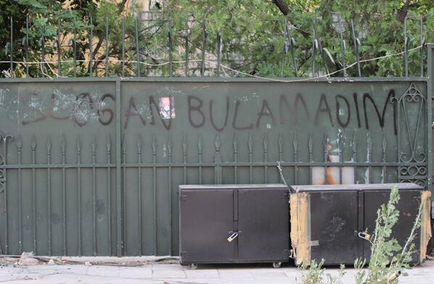
Figure 7
As Göle noted, “The Gezi movement is reuniting people across ancient divides by rejecting the politics of polarization and stigmatization.”[29] For instance, graffiti such as “Slogan buladım” [I could not find a slogan] and “Ne yazacağımı bulamadım ama anarşi falan işte” [I could not find what to write but something like anarchy] again implied a new sense of political appearance through the language in that they broke the mould of old communication practices even among the opposed groups (See Figure 6 and 7). Thus, “Kahrolsun Bağzı Şeyler” [God Damn Some-things] (See figure 8) which has an intentional typo in the word “bağzı” (“some” with the typo in the word) also implies an opposition not only to the government but also to traditional slogans.[30] The writer of this sentence chose not to write “Kahrolsun Faşizm” [god damn fascism] but he meant just “some damn things.” We can say that these were the protesters’ new approach to communication strategies of the opposed groups, which have already defined themselves through the old slogans. Thereby, referring to Arendt, the spoken words in which the protesters has identified themselves as the actors, announcing what he does, has done, and intends to do.[31]
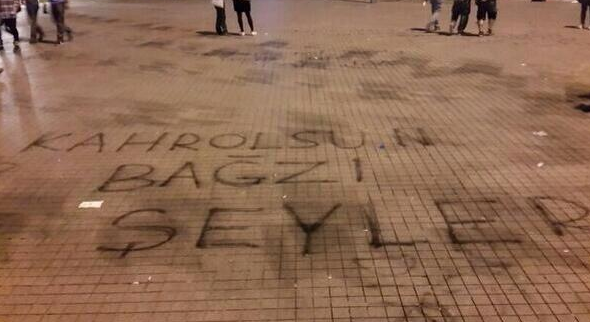
Figure 8
As a result, the space, wherein they gathered-together, without any mediation, enabled knowing the other by touching each other and listening to each other which reopens the prior histories of encounter that violate and fix others in regimes of differences.[32]
This was the result of the space, which brought them together. It was also a result of the online space, “the extended Gezi,” which enabled protesters' reporting, following, retweeting through their own media. All Gezi action turned into a response to the other, who appeared as such since they were in the streets, and each had their own media.[33] So they came to know that no one but themselves should represent them.
As the second element of the politics of “being-there,” the protesters also fought against current structures of representation since they learned that traditional media does not cover or represent real situations. That is why the Gezi Movement was also a call for democratic media. Within the democratic space, social media, despite the deficiencies of the information flow, was the foremost way to raise the voice of the protesters. They created their own media in order to represent themselves since they realized that the media did not choose to represent them; during the demonstrations, there was no real coverage of the growing protests and police violence. Even CNN International showed Gezi Park and Taksim Square, while in the meantime CNN-Turkey (one of the Turkish mainstream media channels) chose to air a documentary about penguins. This became a joke among the protesters, and they dubbed the mainstream media “penguin media” (see Figure 9).
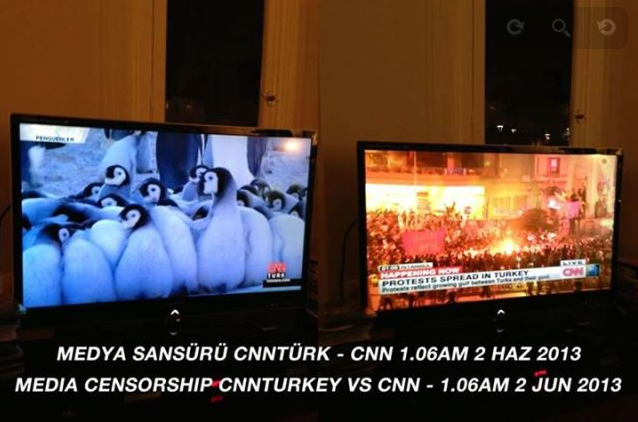
Figure 9 CNN Turk vs. CNN International
Nevertheless the protesters, as citizen-journalists and online activists, created their own space by using Twitter, Facebook and u-stream media as a form of simultaneous broadcasting. The information flow included information about walking paths to avoid tear gas, or how to reach the health desk. At the beginning of the demonstration, this information flow caused confusion. In some cases, the information posted about police attacks among other incidents was incorrect but the protesters became increasingly self-aware and reported more accurate and valid information.
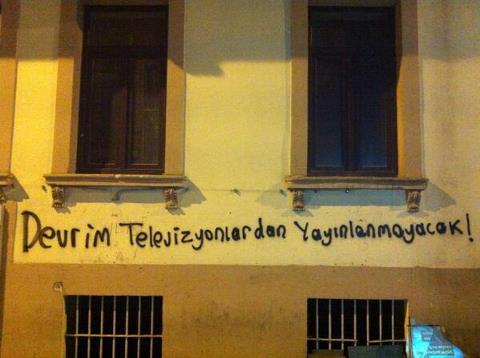
Figure 10 Revolution will not be televised via showdiscontent.com
In addition to the protesters’ own social media spaces, the Gezi Movement created its own guerilla media[34] such as Gezi Radyo [Gezi Radio],[35] Çapul TV [which defines itself as Media of the Resistance] and Naber Medya [What’s up Media]. The reporters from Çapul TV and Naber Medya broadcasted online both from Gezi Park and from other neighborhoods. For this reason, they published “the revolution” using their own media outlets.
A banner that journalists carried read, “Resistance also frees the media” (see Figure 11). Additionally, referring to the mainstream media outlets that didn’t air the demonstrations, one of the banners read, “Now, do you understand why every Kurd has two satellites in their homes?” (See Figure 12). This banner referred to the OHAL [State of Emergency Rule] in the Southeast, introduced in 1987, which made it harder to get information. By the early 1990s, there was one source to get information which was the emergency governor’s office. By the end of 1993, journalism could not be relied upon for reporting other than the dictates of political power.[36] For this reason, the banner also implies that Kurds have their own local channels in order to be informed about the news since Turkish media not only manipulates the news but also does not show them,[37] like in the case of the Roboski Airstrike in 2011.[38]
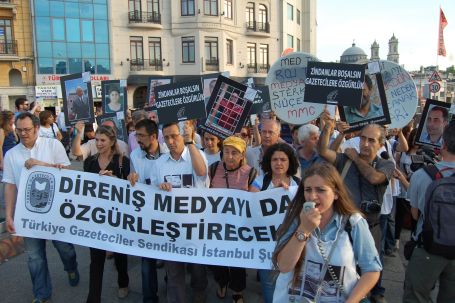
Figure 11 Journalist supporting the demonstration (June 6th, 2013)
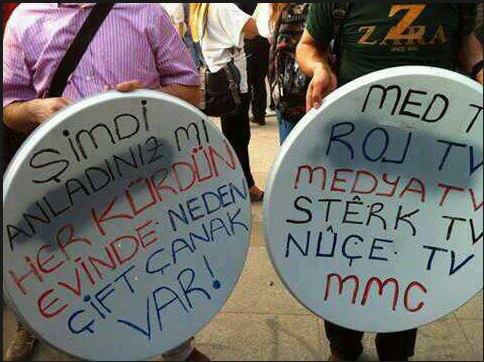
Figure 12 Now do you understand why each Kurd has two satellites in their homes (On the Left). Names of the Kurdish Local TV Channels (On the Right)
One may say that the expansive potential of social media cannot be freed from its shortcomings. In other words, it contains an expansive freedom of expression but, at the same time, it relies on surveillance mechanisms that may in fact end up tracking down the very agents enabling these very expansive freedoms. One might also say that social media function as a mechanism of power and resistance. For instance, the government banned YouTube and Twitter in March 2014 but the users learned how to change their DNS and VPN setting to circumvent the social media bans imposed upon them.
The youth were there as “extended iPhones.”[39] Thanks to these mobile devices, protesters learned the potential elasticity of the social space[40] which triggered their online practices, including the call for organization and the questions asked to the members of the ruling party via twitter.[41]They supported and defended online media platforms, which broadcast in Gezi Park without requiring any other media. Also, thanks to the corporeal communication, the space enabled them to appear to each other as such. So their participation practices showed the new politics of communication between new political agents. Even at the beginning of the occupation, the protesters did not use “mediated violence,” which was committed through the imposed ideas (like Kurds are “terrorists” in the eyes of most nationalists) to recognize the other since they instantly learned that the media set the boundaries; the media perpetrates violence while knowing and informing about the other. The underlying reason behind the politics of “being-there” is to see the potential of plurality. The new politics did not emerge from the knowledge but a failure of the knowledge. In other words, the Gezi Movement was an awakening: it was about seeing what we can do when we are being-together. One may still say that the movement was entirely indebted to being-there in the streets. But this would be just an orthodox way of thinking. Since the motto of the Gezi Resistance was “Everywhere is Taksim, Everywhere is Resistance,” it would not be so naïve to say that even retweeting an accurate account from home, banging pots and pans from their balconies or windows and therefore not being in the street, did contribute to the resistance. It was not enough, but it still implies “the Gezi Spirit.”[42] As Arendt writes, “wherever you go, you will be a polis,” and we can say that “wherever they go, they will be Gezi,” which can find its proper location almost any time and anywhere.[43]
All in all, the movement was triggered by being-there in the offline spaces, which became a “space of appearance,” enabling the political agents in “sharing of the words and deeds” to know and to appreciate “being singular plural,” and it was strengthened with the e-participation of the protesters (such as tweeting, mentioning--@, and publishing online). Being online in the street was the basic feature of the movement that also demonstrated how online participation was crucial for producing the political practices, since social media spaces enabled the protestors to know and hear about each other during the movement. Also, during the movement, the “extended Gezi” provided information about the voice of the people who are not heard through mainstream media outlets. For this reason, the Gezi Media informed the people about the boundaries that the media proceeded to establish. Also, the old revolutionaries and the digital-activist youth of Turkey exchanged experiences and learned to know each other, demanding universal human rights by being-together. In the short run, this plurality in the movement inherently allowed people to share their own “political” ideals in addition to spreading new methods of political communication through both offline and online participation practices. And in the long run, it created the possibility for new types of organized counter-political “appearances” to change the current situation in Turkey. That is why Gezi was just a beginning, and as they always shout, “the struggle continues” in the names of the eight people killed by the police brutality.
Notes
[1] The Movement was actually triggered on May 28th of 2013, and continued until the police attacked the protesters at Gezi Park in İstanbul on June 16th, 2013, at which point the occupation was terminated. Yet, as the protestors always shout, “This is just a beginning, the struggle continues.” Activists continue to protest online by using various hashtags that indicate relevant events in Turkey such as #berkinelvan (which refers to a person hit by gas canister when he was 15 years old, and after over 200 days in coma finally passed away), #youtubeblockedinturkey, #twitterblockedinturkey, #twittericinsokagacikiyoruz, (we will protest the ban on twitter in the streets), #internetimedokunma (don't touch the internet), #soma and #generalstrike (referring to the mine explosion that caused the death of over 400 people). The activists have continued to protest it in the streets. Also, the phrase, “the Gezi Movement,” does not refer to only the demonstrations in Istanbul but all the other demonstrations in different provinces. The movement spread beyond Istanbul, to about 70 cities in Turkey (most significantly Ankara, Eskişehir, İzmir, Antakya).
[2] Even all the surveys can have insufficient results, the KONDA Survey gives some insight to demographics of the people. 30, 8 percent of them was in the ages between 21-25, and 20.3 percent of them were between 26-30 years old. See: http://translateforjustice.com/2013/06/26/konda-survey-on-gezi-park/; About KONDA: Research and Consultancy is a public opinion research and consultancy company established in 1986 by Tarhan Erdem (accessed 14 July 2014) (http://www.konda.com.tr/en/about_us.php.
[3]See http://www.buzzfeed.com/lemoustache/25-examples-of-the-best-street-humour-from-istanbu-b7x9 (accessed 9 July 2014).
[4] Like texting to each other, they wrote shortened version of the words on the walls and made intentional typos.
[5]These are also joyful practices intended to create laughter, which brought them together. As Hannah Arendt writes, “The greatest enemy of authority, therefore, is contempt, and the surest ways to undermine it is laughter.” Arendt, On Violence (Houghton Mifflin Harcourt, 1970), 45.
[6] In order to get the government to respond, the protesters created hashtags such as #cevapver (answer), mentioned officials of the ruling party (like @valimutlu), asked questions about the Gezi Park and criticized police brutality through Twitter. According to hashtracking.com #occupygezi and #direngeziparkı was shared 3.748.945 million 2.124.042 millions times respectively.
[7] Even though it is still controversial whether Gezi was a class uprising or not, we know that white collar workers came to Gezi Park after their 9 to 5 working hours. In order to define themselves they used the phrase “Clark Kent by Day, Superman by Night.” http://plazaeylemplatformu.wordpress.com/pep-hakkinda/ (accessed 15 July 2014).
[8] The concept of being-there philosophically refers to Heidegger’s notion of Dasein, which literally means “being-there” or “there-being” in Heideggerian sense. The concept of Dasein indicates the spatiality affirming the internal relation between human being and the world. For Heidegger Dasein is always “in” the world. For Heidegger’s use of Dasein, see Martin Heidegger, Being and Time, trans. J. Stambaugh (Albany, NY: State University of New York Press, 1996 [1927] [1953]).
[9] Hannah Arendt, The Human Condition (Chicago, IL: The University of Chicago Press, 1998 [1958]), 198-9.
[10] Arendt, The Human Condition, 208.
[11]http://scriptogr.am/geziparkarsiv.
[12] It should be noted that the Gezi Movement has both similarities and differences with other occupy movements of the last decade (particularly 2011). See "Comrades from Cairo," "From Taksim and Rio to Tahrir, the smell of teargas," Roarmag.com, 29 June 2013, http://roarmag.org/2013/06/from-tahrir-and-rio-to-taksim-the-smell-of-teargas/ (accessed 15 July 2014). It was similar in the sense that there was an occupation of a public space, i.e. Gezi Park and Taksim Square. Yet, the Gezi Movement did not directly attempt to revolt against or destabilize the neo-liberal economic and political order, nor was it triggered by the financial crisis. Rather, as Göle asserts, the Gezi Movement was set in motion as a protest against democratic majoritarianism. See Nilüfer Göle, "The Gezi Occupation: For a Democracy Public Spaces," Open Democracy, 11 June 2013, http://www.opendemocracy.net/nilufer-gole/gezi-occupation-for-democracy-of-public-spaces (accessed 15 July 2014).Though the financial crisis may have been a compounding factor, it did not trigger nor serve as the primary force behind the revolt of the people against the government. For a significant comparison between other global social movements and Turkey’s, see Cihan Tuğal, “‘Resistance Everywhere’: The Gezi Revolt in Global Perspective,” New Perspectives on Turkey 49 (2013):157-172. The people demanded freedom of expression in the name of egalitarian ideals.
[13] Nevertheless, it is important to note that the squatting was triggered by an opposition to urban renewal schemes, which included the privatization of urban public spaces, so the Gezi Park. The construction sector has gained significant importance since it is the foremost driving force of Turkey’s economy during the AKP’s period
[14] http://showdiscontent.com/archive/gezi-parki/2013-05-30/img/0530-kirmizi.jpg (accessed 15 July 2014.
[15] http://m.theatlantic.com/infocus/2013/06/a-week-of-furious-protest-in-turkey/100529/#img32 (accessed 15 July 2014).
[16] In addition to the neo-liberal political agenda of the AKP, which AKP has supported in order to integrate the Turkish economy into the global market since 2003, a large number of military officials who were believed to coup against AKP government were detained and charged due to the “democracy policy” of AKP. As a result, AKP pretended to end military authoritarianism as a policy of their governance, but the Gezi Movement also showed that Erdoğan has been behaving as the “only man in town” through his speeches and the AKP has been ruling the country with police brutality. Also, the authoritarian governance had already been imposed on the daily life of people through limitations on alcohol consumption and the curtailment of abortion rights by reference to religious discourse. In addition to his religious discourse on abortion, the Prime Minister developed a political discourse in order to impose his ideas on other matters. For instance, in 2012 at Parliamentarians' International Conference on Population and Development, he stated that, “I consider abortion as murder. Nobody should have the right to allow this. You either kill a baby in mother's womb or you kill it after birth. There's no difference.” Then, while giving a speech at AKP Women’s Branch Congress in June 2013, he claimed, “Every Abortion is Uludere." Uludere is used in the state discourse, but it is actually known as Roboski where Turkish F16 jets bombed Kurdish civilians and thirty-four of them (mostly children) were killed on the Turkey–Iraq border on December 28th, 2011. See http://bianet.org/english/english/138659-prime-minister-every-abortion-is-uludere (accessed 15 July 2014). Referring to this, the feminist groups in Gezi, as a cross-reference, responded to Erdoğan’s political discourse with the banner proclaiming: “Abortion is right, Uludere is massacre.” Additionally, the authoritarian governance covered all the following issues: The demonstrations and the celebration of worker’s day (May 1st) in Taksim Square were banned. Detained students and journalists (especially those who are Kurdish) were still in prison due to the so-called anti-terrorism laws, which affiliated them with “illegal organizations.” Also, they planned to demolish the historical and cultural heritage of the city (such as the old Emek Theatre) for the sake of urban renewal in Istanbul. The reactions and opposition to all of these issues were written on the walls during the demonstrations. Unfortunately, the graffiti revived memories of two car bombs that killed at least 43 people and injured at least 100 in the Turkish town of Reyhanli, located near the Syrian border, with the tag “Don’t forget,” as in “Don’t forget Reyhanlı.” See http://www.bbc.com/news/world-middle-east-22494128 (accessed 15 July 2014). Erdoğan described the Gezi Movement as a “continuation of Reyhanlı," and he also added, "Some media organisations, both domestic an international, were prepared for these organised protests." So he blamed Syria for the Reyhanlı Attack, and the so-called "interest rate lobby" for the Gezi Movement. See http://www.ft.com/intl/cms/s/0/a3a6bb2e-d82d-11e2-9495-00144feab7de.html#axzz37excRmxe (accessed 15 July 2014).
[17] Teke Tek. TV Talk Show. 3 July 2013. HaberTurk Channel. https://www.youtube.com/watch?v=V70KvrEOCz0 (accessed 15 July 2014).
[18] Capulcu: A free spirit that wants to free herself/himself from the pressure of authoritarianism. See: http://www.urbandictionary.com/define.php?term=capulcu.
[19] "Everyday I’m çapuling" became the motto of the demonstrations.
[20] This organization has 128 constituents; all of which belong different political groups: http://www.taksimsolidarity.org/ and http://taksimdayanisma.org/page/6?lang=en (accessed 15 July 2014).
[21] Arendt, The Human Condition, 199.
[22] Ibid.
[23] http://listelist.com/gezi-parki-direnisini-anlatan-83-duvar-yazisi/.
[24] Even though surveys are by no means perfect instruments, KONDO survey indicates that 79% of them were not members of any political organization:http://www.bianet.org/english/youth/147543-94-percent-of-gezi-resisters-participate-individually-poll-says (accessed 15 July 2014).
[25] Metaphorically speaking, the people in the street were “singular plural.” According to Jean-Luc Nancy, this refers to “first-person plural” which makes sense of the world as the spacing and intertwining of so many worlds. So were the people were in the Gezi Park and Taksim Square, implying the “heterogeneity of surfaces that touches each other." See Jean-Luc Nancy, Being Singular Plural (Stanford, CA:Stanford University Press, 2000) 5.
[26] Arendt, The Human Condition, 178.
[27] Before the Gezi Movement, one might not have imagined that an LGBTQ person may walk with a religious person shouting anti-government slogans together. Additionally, one might not have imagined seeing the Kurdish Workers Party (PKK) flag or its banner with an image of its leader Abdullah Öcalan, flying in Taksim Square. This was a significant “appearance” since the Turkish state has proclaimed the PKK to be a terrorist organization, which has been reinforced by NATO and the European Union. Nonetheless, a “ceasefire” has been in place as part of an ongoing Peace Process between the Turkish Government and the PKK since 2013.
[28] During the demonstrations, with respect to KONDA Survey, 49.1% of the protestors came to the park after learning about the police brutality through social media; http://www.konda.com.tr/tr/raporlar/KONDA_GeziRaporu2014.pdf (just published, for now it is only in Turkish) (accessed 15 July 2014).
[29] Göle, "The Gezi Occupation."
[30] Sürreyya Evren, one of the well-known anarchist writers in Turkey, referred to this example in one of his talks about Gezi.
[31] Arendt, The Human Condition, 179.
[32] See Sara Ahmed, Strange Encounters:Embodied Others in Post-Coloniality (New York: Routledge, 2000), 8.
[33] In addition to detained journalists who work for some opposing newspapers, during the Gezi Movement, they detained people who used twitter to call for protests: http://www.theguardian.com/world/2013/jun/05/turkish-police-arrests-social-media-protest (accessed 15 July 2014).
[34] The other alternative citizen and activits media platforms were Taksim Dayanışması, Videoccupy, Mustereklerimiz, Hemzemin, ResistTaksim, IstanbuldaNeOluyor, Direnisteyiz.Org, Gezi Radyo. See the list of GeziTabs: http://gezisekmeleri.tumblr.com/ (accessed on 15 July 2014).
[35] "We are the resistance. We are not victims. We are citizens with a duty to defend our commons, and we will not bargain." Listen the voice record by Gezi Radyo: http://www.opendemocracy.net/opensecurity/gezi-radyo/we-take-back-whats-ours (accessed on 15 July 2014).
[36] See the report on Free Expression by Human Rights Watch: http://www.hrw.org/reports/1999/turkey/turkey993-07.htm#P787_170668 (accessed on 15 July 2014).
[37] One of the Kurdish protestors explained this situation with his own words: "For 30 years the Turkish people have not known or understood the war waged against our struggle for democracy and freedom in the southeast, only believing what they have heard from the government and media," See: http://www.aljazeera.com/indepth/features/2013/06/201361214392425995.html.
[38] Even though it was broadcasted by the international media, TV channels in Turkey broke the Roboski news almost 12 hours later. In a statement, Turkish Army said: “A paranormal activity has been detected on our border where terrorists frequently use a gateway. Targets have been bombarded between 9:37 PM and 10:24 PM.” See: http://bianet.org/english/human-rights/143200-timeline-what-happened-in-roboski (accessed on 15 July 2014).
[39] Another graffiti piece read as “#direnIphonesarjı” [#resistIphonebattery]. This was another symbol of their appreciation of the resistance.
[40] The youth—most often criticized for being online, using mobile phones, and knowing nothing about “the real world” especially given the depoliticization of youth after coup d’état of 1980—were the ones who contributed to this uprising most markedly. That is why their mobile phones were a significant aspect of the protests.
[41] See note 6 above.
[42] I borrowed this phrase from sociologist Meyda Yeğenoğlu’s significant article: "Smells like Gezi Spirit: Democratic Sensibilities and carnivelesque politics in Turkey" http://www.radicalphilosophy.com/commentary/smells-like-gezi-spirit. (accessed 15 July 2014).
[43] Arendt, The Human Condition, 198.
Sinem Aydınlı is a Ph.D candidate in Cinema and Media Studies at Bahcesehir University, Istanbul, Turkey. She is a former visiting researcher in the Department of Film and Media Studies at the University of California, Santa Barbara. Her research interests include the ethico-political possibility of communication, the concepts of “mediated violence” and the interruption through the different media forms and the events.